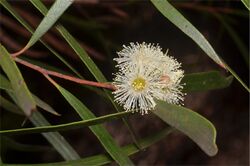Biology:Eucalyptus apiculata
| Narrow-leaved mallee ash | |
|---|---|

| |
| Eucalyptus apiculata habit | |
| Scientific classification | |
| Kingdom: | Plantae |
| Clade: | Tracheophytes |
| Clade: | Angiosperms |
| Clade: | Eudicots |
| Clade: | Rosids |
| Order: | Myrtales |
| Family: | Myrtaceae |
| Genus: | Eucalyptus |
| Species: | E. apiculata
|
| Binomial name | |
| Eucalyptus apiculata R.T.Baker & H.G.Sm.[2]
| |
| Synonyms[2] | |
|
Eucalyptus laophila L.A.S.Johnson & Blaxell | |
Eucalyptus apiculata, commonly known as the narrow-leaved mallee ash[3] and is a mallee that is endemic to New South Wales. It has smooth white or greyish bark, narrow lance-shaped adult leaves, flower buds in groups of three to seven, white flowers and urn-shaped or barrel-shaped fruit.
Description
Eucalyptus apiculata is a mallee with smooth white or greyish bark. Young plants and coppice regrowth have leaves arranged in opposite pairs, linear to narrow lance-shaped leaves up to 160 mm (6 in) long and 8–20 mm (0.3–0.8 in) wide. They are the same glossy green colour on both sides. Adult leaves are narrow lance-shaped, 35–110 mm (1–4 in) long and 3–7 mm (0.1–0.3 in) wide, the same glossy green on both sides. There is a small point or hook on the end of the leaves. The flower buds are arranged in groups of three to seven, the groups on a peduncle 5–10 mm (0.2–0.4 in) long and the individual flowers a pedicel 2–5 mm (0.08–0.2 in) long. The mature buds are oval to club-shaped, 5–8 mm (0.2–0.3 in) long and 3–4 mm (0.1–0.2 in) wide with a conical operculum that has a small point on its top. Flowering occurs between October and March and the flowers are white. The fruit is an urn-shaped or barrel-shaped capsule 6–9 mm (0.2–0.4 in) long and 6–8 mm (0.2–0.3 in) wide on a pedicel 2–6 mm (0.08–0.2 in) long.[4][5][6]
Taxonomy and naming
Eucalyptus apiculata was first formally described in 1902 by Richard Thomas Baker and Henry George Smith who published the description in a paper entitled A research on the eucalypts : especially in regard to their essential oils.[7] The specific epithet (apiculata) is a Latin word meaning "apiculate", referring to the leaves.[5]
Distribution and habitat
The narrow-leaved mallee ash is a rare species with a restricted distribution between Linden and Berrima where it grows in mallee shrubland.[4]
References
- ↑ Fensham, R.; Collingwood, T.; Laffineur, B. (2019). "Eucalyptus apiculata". IUCN Red List of Threatened Species 2019: e.T133377804A133377806. doi:10.2305/IUCN.UK.2019-3.RLTS.T133377804A133377806.en. https://www.iucnredlist.org/species/133377804/133377806. Retrieved 20 September 2021.
- ↑ 2.0 2.1 "Eucalyptus rodwayi". Australian Plant Census. https://biodiversity.org.au/nsl/services/apc-format/display/95023.
- ↑ Brooker, M.I.H.; Kleinig, D.A. (2006). Field Guide to Eucalypts (Volume 1: South-eastern Australia) (3 ed.). Melbourne: Bloomings Books. p. 312. ISBN 1876473525.
- ↑ 4.0 4.1 Hill, Ken. "Eucalyptus apiculata". Royal Botanic Garden Sydney. http://plantnet.rbgsyd.nsw.gov.au/cgi-bin/NSWfl.pl?page=nswfl&lvl=sp&name=Eucalyptus~apiculata.
- ↑ 5.0 5.1 "Eucalyptus apiculata". Euclid: Centre for Australian National Biodiversity Research. https://apps.lucidcentral.org/euclid/text/entities/eucalyptus_apiculata.htm?zoom_highlight=Eucalyptus+apiculata.
- ↑ Chippendale, George McCartney. "Eucalyptus apiculata". Australian Biological Resources Study, Department of the Environment and Energy, Canberra. https://profiles.ala.org.au/opus/foa/profile/Eucalyptus%20apiculata.
- ↑ "Eucalyptus apiculata". APNI. https://id.biodiversity.org.au/instance/apni/455553.
Wikidata ☰ Q11157304 entry
 |




